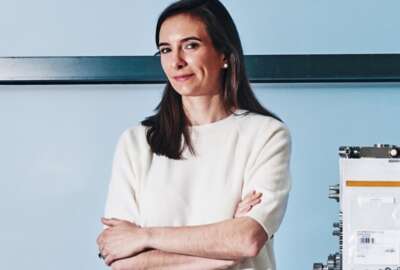Hubbard Radio Washington DC, LLC. All rights reserved. This website is not intended for users located within the European Economic Area.
Big breakthrough for beyond-line-of-sight communications in the U.S. Military
here has been a significant achievement for DoD’s Space Development Agency. Last month, SDA demonstrated it could use a communication system called Link 16 be...
There has been a significant achievement for DoD’s Space Development Agency. Last month, SDA demonstrated it could use a communication system called Link 16 between ground stations and its new network of low-earth orbiting satellites. It is the first time the ubiquitous military communication protocol has ever been used in space. For more on why that matters and what it means, Federal News Network Deputy Editor Jared Serbu talked with Jennifer Elzea, SDA’s Director of Strategic Engagement on the Federal Drive with Tom Temin.
Interview Transcript:
Jared Serbu Jennifer, thanks very much for joining us. And I think to set this up to help folks understand why this is such a big deal, it’d be useful to understand a little bit what Link 16 is for people who have not worked in military communications. Can you set us up that way and tell us, you know, what this communications protocol is used for and why you guys decided to prioritize it as part of your transport architecture?
Jennifer Elzea You bet. Thanks, Jared. So Link 16 is a specific military communication channel over radio specifically that allows tactical messages to be delivered to warfighters around the world. And the importance of it right now is that from space we can expand its deliverable location out to the edge of where a warfighter might be. Previously Link 16, which has been around for several decades with limited to an area where it had to be about 200 or 300 nautical miles from another Link 16 radio. And now with the potential use from space. We’ve expanded that footprint significantly where a warfighter can be almost anywhere in the world and have like 16 military data messages delivered to them wherever they are.
Jared Serbu Right. Because I think the main limitation was also limited to line of sight, right? But if you’re in space, line of sight is potentially everywhere.
Jennifer Elzea That’s exactly right. We historically have fought wars primarily using within line of sight. And now with the opportunity to deliver data to a warfighter from space through the proliferated warfighter space architecture, which is what my agency is building, we do have beyond line of sight capability for Link 16 tactical messages. And that’s one of the areas that the PWSA architecture can deliver. But in the future, we will test and demonstrate other channels through which we can also deliver data. But Link 16 is a very significant one because of its military history.
Jared Serbu Right. And what can you share with us about what this particular set of tests actually demonstrated? And whatever the test scenario, whatever you could share on that would be would be helpful.
Jennifer Elzea This test took place a couple of days before Thanksgiving, which was very exciting. We tested three different occasions with three different satellites in low earth orbit. So the satellites are about 1000km from the earth as part of our Tranche 0, which is our demonstration generation of the PWSA. And the satellites that we used for testing have Link 16 radios aboard, and they were connecting to Link 16 radios in an international partners territory on the ground. Our international partners have been very helpful and forward leaning about this Link 16 testing. And so we had to go through a U.S. government waiver process and also an international approval process to be allowed to do this testing in the territory of a foreign partner. And the Link 16 radios from space, we’re able to both actively and passively connect to link 16 radios on the ground and pass messages each way. And that active and passive is important because active connection means that there is sort of a digital handshake. Passive connection means that it can also connect even without that digital handshake. If it has the appropriate authorities for the network, it’s able to connect without as much process as a satellite might move overhead.
Jared Serbu What’s the connection that or how does SDA think about the connection of this new capability to the broader joint all domain command and control effort? Or I guess now since you’re working with the international partners combined at joint all main command and control?
Jennifer Elzea Yes, it’s a real possibility. So Joint All Domain and Control or JADC2 is the pop term for it is really about connecting any sensor in the world or in space potentially to any shooter anywhere in the world. There’s a lot of quote unquote, magic that’s involved with making something like that happen. And this Link 16 test is a real demonstration that that magic, if you will, is possible. So allowing military messages to be passed from space to ground does enable the idea, at least of any sensor anywhere in the world being able to pick up whatever data it is that we need and move it potentially through space to wherever the warfighter who needs to use or apply that data wherever they’re located, and then send it down to the ground via Link 16 or like I said, in the future, potentially other channels. That’s a very real. Step toward enabling JADC2 versus a lot of discussion and a lot of efforts that have been underway. But this is a demonstration that shows us one of the pieces that’s going to make JADC2 possible.
Jared Serbu And one thing we haven’t really emphasized yet is it seems like another important part of this is this is a generation of satellite communication that doesn’t require the end user to have a big satellite terminal. Right? I mean, we’re talking really about something in a form factor of a handheld radio. Right. That is completely mobile. Is that about right?
Jennifer Elzea Yeah, that’s an excellent point and a really important part of this discussion. From the outset, the Space Development Agency was committed to building toward what already existed. We did not want to force the military services to reequip based on what it was that we were going to fly in space. Certainly military communication channels will move forward over time. There may be other receivers or other channels in the future, but we didn’t want to be the forcing function for that at SDA. So we built to what existed. And there are, you’re right, very relatively small and transportable radios that can receive Link 16 messages as small as something that someone can hold in their hand or can be mounted to a vehicle, which again, with that beyond line of sight capability is very important because if you are at the edge, the tactical edge in some sort of war fighting scenario, you don’t want to have to be bringing new or different equipment that warfighters might not be trained on. And you don’t want a huge footprint to have to drag with you.
Jared Serbu Makes sense. So what can you share with us about what needs to happen still before this is in real operational use and what’s next in the test plan?
Jennifer Elzea Yeah, so this is a very early demo. This is like I mentioned, the PWSA is Tranche 0, which is a demonstration generation. So the satellites that are on orbit today that perform these tests are not operational satellites. They’re really for demonstration. But SDA employs a spiral development model, which means that every two years we field a new generation of capabilities in space as well as that company and ground support whatever is needed. So beginning at the end of 2024. So really just about a year from now we will begin launching our first operational generation and that will be outfitted with Link 16 radios as well as optical links, which is using a whole separate frequency of the light spectrum to move data within space and potentially to the ground in addition to this Link 16 capability. So beginning in 2024, we will start flying our first operational generation and then in 2025, we really will achieve probably initial warfighting capability, which is what we call our ability to support the warfighter in an active fight if necessary, sometime around the end of 2025.
Jared Serbu And I just want to give folks a sense of how quickly SDA is moving in comparison to most military acquisition projects. I think that Tranche 1 that you mentioned, you said it’s going to be flying in 2024. I think the contract awards were just a couple of months ago for that. Am I remembering that timeline right?
Jennifer Elzea The contract awards typically. So the ones for these radios, the demonstrated Link 16 just a week ago, those contracts were let in 2020, the contracts for Tranche 1 were let in about 2022 time frame. And then we right now are buying yet another generation called Tranche 2 that will begin flying in 2026. So we are moving you’re right at the speed of light if you will. And our agency as a whole stood up in 2019. So we’ve gone in under five years. We’ve gone from nothing, you know, paper to demonstration on orbit. We’re moving toward operational capabilities on orbit. And then yet another build out and replenishment generation for Tranche 2 in 2026. So the agency is moving very, very quickly to deliver these capabilities to our warfighters.
Copyright © 2024 Federal News Network. All rights reserved. This website is not intended for users located within the European Economic Area.
Jared Serbu
Jared Serbu is deputy editor of Federal News Network and reports on the Defense Department’s contracting, legislative, workforce and IT issues.
Follow @jserbuWFED
Related Stories
On DoD

WEDNESDAYS, 11 A.M. & 2 P.M.
Each week, Defense Reporter Jared Serbu speaks with the managers of the federal government's largest department. Subscribe on PodcastOne or Apple Podcasts.
Related Stories
-
The Space Development Agency lands upon a new, permanent home Federal Newscast
-
It’s getting awfully crowded up in the low-Earth orbit area The Space Hour





